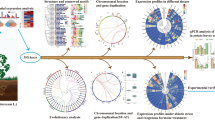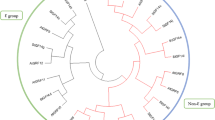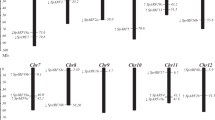Abstract
The aim of this study was to identify members of potato GATA gene (StGATA) family and to provide information for further study on the regulatory role of StGATA transcription factors in potato growth and development and biotic and abiotic stresses. Based on the whole potato genome data, the members of potato GATA transcription factor family were identified and systematically analyzed by bioinformatics online analysis website and software. In total, forty-nine GATA proteins from Solanum tuberosum were identified. Phylogenetic analysis revealed that these GATA proteins could be divided into 5 subfamilies. The gene structure and conserved motif analysis revealed that many genes have more than one intron. Forty-nine StGATA genes were distributed on 12 chromosomes randomly. A cis-element analysis inferred that StGATAs contain abiotic stress-related elements. A heatmap showed that many StGATAs are generally expressed in tissues at different developmental stages. A representative member StGATA9 was selected for screening its expression characteristics to identify whether it was induced by Ralstonia solanacearum, abscisic acid (ABA) and methyl jasmonate (MJ) treatment. Quantitative real-time polymerase chain reaction (qRT-PCR) assays indicated that StGATA9 was induced by R. solanacearum. And StGATA9 was up-regulated by different concentrations of ABA and MJ. Tissue localization showed that StGATA9 was mainly expressed in phloem of leaf vascular bundles and stem vascular system. These results provide a theoretical basis for further experimental cloning and functional verification of the gene, while provides a theoretical basis for the study of molecular mechanism of resistance to bacterial wilt in potato.









Similar content being viewed by others
Abbreviations
- ABA:
-
Abscisic acid
- MJ:
-
Methyl Jasmonate
- GATA TF:
-
GATA transcription factors
- BME3:
-
BLUE MICROPYLAR END3
- RSSC:
-
Ralstonia solanacearum species complex
- BW:
-
Bacterial wilt
- SSH:
-
Suppression subtractive hybridization
- CO:
-
Constans
References
Bai Y, Meng Y, Huang D et al (2011) Origin and evolutionary analysis of the plant-specific TIFY transcription factor family. Genomics 98(2):128–136
Bali S, Robinson BR, Sathuvalli V et al (2018) Single nucleotide polymorphism (SNP) markers associated with high folate content in wild potato species. PLoS ONE 13(2):e0193415
Behringer C, Bastakis E, Ranftl QL et al (2014) Functional diversification within the family of B-GATA transcription factors through the leucine-leucine-methionine domain. Plant Physiol 166(1):293–305
Blaudez D, Kohler A, Martin F et al (2003) Poplar metal tolerance protein 1 confers Zinc tolerance and is an oligomeric vacuolar zinc transporter with an essential leucine zipper motif. Plant Cell 15(12):2911–2928
Chen JY, Li NY, Ma XF et al (2017a) The ectopic overexpression of the cotton Ve1 and Ve2-homolog sequences leads to resistance response to verticillium wilt in Arabidopsis. Front Plant Sci 8:844
Chen HF, Shao HX, Li K et al (2017b) Genome-wide identification, evolution, and expression analysis of GATA transcription factors in apple (Malus×domestica Borkh.). Gene 639(3):137–148
Denancé N, Ranocha P, Oria N et al (2013) Arabidopsis wat1 (walls are thin1)-mediated resistance to the bacterial vascular pathogen, Ralstonia solanacearum, is accompanied by cross-regulation of salicylic acid and tryptophan metabolism. Plant J 73(2):225–239
Dereeper A, Audic S, Claverie JM et al (2010) Blast-explorer helps you building datasets for phylogenetic analysis. BMC Evol Biol 10(1):8
Gupta P, Nutan KK, Singla-Pareek SL et al (2017) Abiotic stresses cause differential regulation of alternative splice forms of gata transcription factor in rice. Front Plant Sci 8:1944
He LY, Sequeira L, Kelman A (1983) Characteristics of strains of Pseudomonas solanacearum from China. Plant Dis 67:1357–1361
Kemal K, John MM (2013) MYC2: the master in action. Mol Plant 6(3):686–703
Kong CY, Luo YP, Duan TT et al (2016) Potato remorin gene strema4 cloning and its spatiotemporal expression pattern under Ralstonia solanacearum and plant hormones treatment. Phytoparasitica 44(4):575–584
Lescot M, Déhais P, Thijs G et al (2002) PlantCARE, a database of plant cis-acting regulatory elements and a portal to tools for in silico analysis of promoter sequences. Nucleic Acids Res 30:325–327
Liang Y, Wan N, Cheng Z et al (2017) Whole-genome identification and expression pattern of the vicinal oxygen chelate family in rapeseed (Brassica napus L.). Front Plant Sci 8:745
Liu PP, Koizuka N, Martin RC et al (2005) The BME3 (Blue Micropylar End 3) GATA zinc finger transcription factor is a positive regulator of Arabidopsis seed germination. Plant J 44(6):960–971
Liu X, Zhu XL, Wei XN et al (2019) The wheat LLM-domain-containing transcription factor TaGATA1 positively modulates host immune response to Rhizoctonia cerealis. J Exp Bot 71(1):1
Lowry JA, Atchley WR (2000) Molecular evolution of the GATA family of transcription factors: conservation within the DNA-binding domain. J Mol Evol 50(2):103–115
Marzluf GA (1997) Genetic regulation of nitrogen metabolism in the fungi. Microbiol Mol Biol Rev 61(1):17–32
Marzluf GA (2004) Multiple fungal GATA transcription factors and combinatorial gene regulation. Biochemistry and molecular biology. Springer, Berlin, pp 111–119
Niu J, Homan TG, Arentshorst M et al (2015) The interaction of induction and repression mechanisms in the regulation of galacturonic acid-induced genes in Aspergillus niger. Fungal Genet Biol 82:32–42
Nussbaumer T, Kugler KG, Bader KC et al (2014) RNASeq expression browser-a web interface to browse and visualize high throughput expression data. Bioinformatics 17:2519–2520
Pang PX, Shi L, Wang XJ et al (2019) Cloning and expression analysis of the StCUL1 gene in potato. J Plant Biochem Biot 28:460–469
Peeters N, Guidot A, Vailleau F et al (2013) Ralstonia solanacearum, a widespread bacterial plant pathogen in thepost-genomic era. Mol Plant Pathol 14(7):651–662
Peng WY, Ning Z, Ting L et al (2019) Genome-wide identification and expression analysis of StTCP transcription factors of potato (Solanum tuberosum L.). Comput Biol Chem 78:53–63
Pikkarainen S, Tokola H, Kerkelä R et al (2004) GATA transcription factors in the developing and adult heart. Cardiovasc Res 63(2):196–207
Ranftl QL, Bastakis E, Klermund C et al (2016) LLMdomain containing B-GATA factors control different aspects of cytokininregulated development in Arabidopsis thaliana. Plant Physiol 170(4):2295–2311
Ravelomanantsoa S, Vernière C, Rieux A et al (2018) Molecular epidemiology of bacterial wilt in the madagascar highlands caused by andean (Phylotype IIB-1) and african (Phylotype III) brown rot strains of the Ralstonia solanacearum species complex. Front Plant Sci 8:2258
Ravindran P, Verma V, Stamm P et al (2017) A Novel RGL2-DOF6 complex contributes to primary seed dormancy in Arabidopsis thaliana by regulating a GATA transcription factor. Mol Plant 10(10):1307–1320
Reyes JC, Muro-Pastor MI, Florencio FJ (2004) The GATA family of transcription factors in Arabidopsis and rice. Plant Physiol 134(4):1718–1732
Richter R, Behringer C, Müller IK et al (2010) The GATA-type transcription factors GNC and GNL/CGA1 repress gibberellin signaling downstream from DELLA proteins and Phytochrome-interacting factors. Genes Dev 24(18):2093–2104
Scazzocchio C (2000) The fungal GATA factors. Curr Opin Microbiol 3(2):126–131
Schmittgen TD, Livak KJ (2008) Analyzing real-time PCR data by the comparative CT method. Nat Protoc 3(6):1101–1108
Tong Q, Dalgin G, Xu H et al (2000) Function of GATA transcription factors in preadipocyte-adipocyte transition. Science 290(5489):134–138
Tsai FY, Keller G, Kuo FC et al (1994) An early haematopoietic defect in mice lacking the transcription factor GATA-2. Nature 371(6494):221–226
Vanholme B, Grunewald W, Bateman A et al (2007) The TIFY family previously known as ZIM. Trends Plant Sci 12(6):239–244
Xu Z, Xuan XZ, Chen CL et al (2019) Comprehensive analysis of multiprotein bridging factor 1 family genes and SlMBF1c negatively regulate the resistance to Botrytis cinerea in tomato. BMC Plant Bio 19:437
Zhang YC, Gao M, Singer SD et al (2012) Genome-wide identification and analysis of the TIFY gene family in grape. PLoS ONE 7(9):e44465
Zhang CJ, Hou YQ, Hao QG et al (2015) Genome-wide survey of the soybean GATA transcription factor gene family and expression analysis under low nitrogen stress. PLoS ONE 10(4):e0125174
Zhang Z, Ren C, Zou LM et al (2018) Characterization of the GATA gene family in Vitis vinifera: genome-wide analysis, expression profiles, and involvement in light and phytohormone response. Genome 61:713–723
Zou Z, Zhu J, Zhang X (2019) Genome-wide identification and characterization of the Dof gene family in cassava (Manihot esculenta). Gene 687:298–307
Acknowledgements
This study is supported by the National Natural Science Foundation of China (31771858), the Shanxi Excellent Graduate Innovation Project of China (2019SY321) and Scientific and Technological Innovation Project of School-level Postgraduates of Shanxi Normal University (2019XSY029).
Author information
Authors and Affiliations
Corresponding author
Ethics declarations
Conflict of interest
The authors declare that they have no conflict of interest.
Additional information
Publisher's Note
Springer Nature remains neutral with regard to jurisdictional claims in published maps and institutional affiliations.
Rights and permissions
About this article
Cite this article
Yu, R., Chang, Y., Chen, H. et al. Genome-wide identification of the GATA gene family in potato (Solanum tuberosum L.) and expression analysis. J. Plant Biochem. Biotechnol. 31, 37–48 (2022). https://doi.org/10.1007/s13562-021-00652-6
Received:
Accepted:
Published:
Issue Date:
DOI: https://doi.org/10.1007/s13562-021-00652-6




